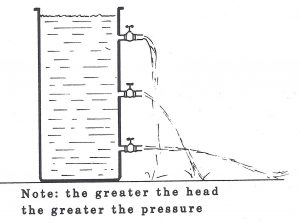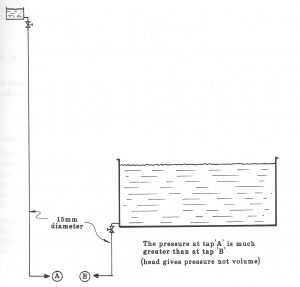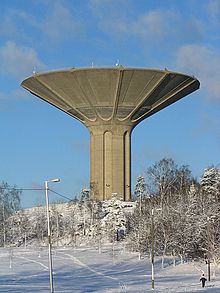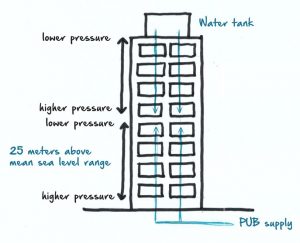‘We need high pressure to get a decent flow rate from our shower and thus a satisfying shower experience’. I often say this and it is true. But it’s not the whole story. I had planned for this blog to be a bit of a bish bosh… ‘the greater the pressure the greater the flow rate the better the shower… and then regulate the flow to 7.5 litres/minute and you’ll have a really good shower but the flow rate won’t be crazy’… blog. Only somehow it got far more complicated than that as I sank into a world of fluid dynamics. Lucky I grabbed hold of a lifebuoy, resurfaced and, hopefully, will manage to simplify thigs a bit while still imparting a decent bit of info.
‘The standard SI unit for pressure measurement is the Pascal (Pa) which is equivalent to one Newton per square meter (N/m2)’ – a statement that always blows my mind a bit. Luckily, in plumbing systems, we measure pressure in bars, which is far simpler. To link it back to Newtons, 1 bar = 1 KiloPascal (1,000 Pascals).
We get pressure into a water system in two ways. Either by the height the water is above the draw off point, or by using pumps. So in a building where water is stored at high level in storage cisterns, that creates the pressure in the pipework. And, as neatly shown in the diagram below left it doesn’t matter how small that volume of stored water is because it’s the head (the height) that gives the pressure. Every 1m head gives approximately 0.1 bar pressure, and therefore 1 bar is the same as 10m head.
In the mains supply the pressure is created either by storage reservoirs on higher ground, water towers (in effect massive storage cisterns out in the open) or pumps again. The pressure in a building from the mains supply depends on how high that building is in relation to the service reservoir or water tower or how close it is to one of the pumps. In the mains supply, high pressure is common in low lying areas and low pressure is common in higher lying areas.
Because head gives pressure, as you come down a building where the pipework is fed by water held in a storage cistern, the pressure increases. And, if the supply pipework is fed from the mains as you go up a building then the pressure decreases.
The pressure at a shower head varies from as little as 0.1 or 0.2 bar (in this case the storage cistern being 1-2 m above the shower head), through (usually) 1 – 3 bar in the UK if it’s being fed from the mains, to 3 bar or upwards if connected to a shower pump. But then things get a bit more complicated when we turn the shower on.
Static v dynamic water pressure
This is because there are two types of pressure, static and dynamic. Dynamic pressure is lower than static pressure. Pressure loss, also known as pressure drop, is the decrease in pressure as measured between two points in a flowing fluid system because as soon as water starts flowing you lose pressure due to frictional resistance within the pipework (basically the water scraping along the sides of the pipe and slowing down). Other causes of pressure loss (or pressure drop) are sudden changes in direction in the pipework, other draw-off points being opened and the flow rate. Up to certain limits, the higher the flow rate, the greater the pressure drop, and vice versa. Within the mains supply the pressure depends on how much water is being used by other customers on the same supply. Pressure will vary at different times of the day – it is usually lower in the mornings and early evening when demand (the number of customers using the water supply) is greater. Dynamic pressure can be improved by larger diameter pipework, fewer bends and lower velocity.
 If you increase the pressure and everything else stays the same then the flow rate increases, as can be seen from the diagram on the left. When the length of pipework to each tap is the same and each tap is open the same amount, then the water comes out faster/spurts out further from the bottom tap. And, by extension, that supply at the bottom would give a higher flow rate from any shower head. Indeed, a shower head fitted to the top fitting would be likely to produce a dribble of water at best.
If you increase the pressure and everything else stays the same then the flow rate increases, as can be seen from the diagram on the left. When the length of pipework to each tap is the same and each tap is open the same amount, then the water comes out faster/spurts out further from the bottom tap. And, by extension, that supply at the bottom would give a higher flow rate from any shower head. Indeed, a shower head fitted to the top fitting would be likely to produce a dribble of water at best.
To recap, the flow rate from your shower is dependent on dynamic pressure and not static pressure. And dynamic pressure changes depending on a host of things. So, in two buildings next to each other in a street, it’s possible for the same shower head to perform in different ways. And we will check out why in the next blog…



